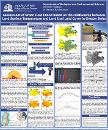Assessment of Urban Heat Islands Based on the Relationship Between Land Surface Temperature and Land Use/Land Cover in Greater Doha
| Author | Siddiqui, Simil Amir |
| Available date | 2020-10-22T07:00:25Z |
| Publication Date | 2020 |
| Publication Name | Qatar University Annual Research Forum & Exhibition 2020 |
| Citation | Siddiqui S.A. "ASSESSMENT OF URBAN HEAT ISLANDS BASED ON THE RELATIONSHIP BETWEEN LAND SURFACE TEMPERATURE AND LAND USE/LAND COVER IN GREATER DOHA", Qatar University Annual Research Forum and Exhibition (QUARFE 2020), Doha, 2020, https://doi.org/10.29117/quarfe.2020.0108 |
| Abstract | Urban heat islands (UHI) are areas with elevated temperatures occurring in cities compared to surrounding rural areas. This study realizes the lack of research regarding the trends of UHIs in desert countries and focuses on Doha. The research includes twelve months of two-time periods; 2000-2019. ArcGIS software was used to compute the land surface temperature (LST) of the city using Landsat images. Land use/land cover (LULC) maps were computed to show how the city has evolved in 19 years. 30 field samples were used to verify the accuracy of the LULC. Results showed UHI in Doha did not display similar pattern to that of cities in subtropical and temperate regions. Higher temperatures were prevalent in out-skirts comprising of barren and built-up areas with high population and no vegetation. Comparatively, the main downtown with artificially planted vegetation and shade from skyscrapers created cooler microclimates. The overall LST of greater Doha has increased by 0.7°C from 2000 to 2019. Furthermore %LULC of built up, vegetation, barren land, marsh land and water body were 29%, 4.5%, 58.6%, 2.8% and 5% in 2000 and 56.5 %, 8.2%, 33.2 %, 0% and 2.1% in 2019 respectively. Overall there was an increase in built-up and vegetation, decrease in water and barren areas and complete loss of marsh land. Highest temperatures were recorded for marsh land area in year 2000 and barren and built in year 2019. Transect profiles showed positive correlation between NDBI and LST and a negative correlation between NDVI and LST. |
| Language | en |
| Publisher | Qatar University Press |
| Subject | Urban Heat Island (UHI) Land use/Land cover (LU/LC) Land surface temperature (LST) Remote sensing Urbanization |
| Type | Poster |
Files in this item
This item appears in the following Collection(s)
-
Theme 1: Energy, Environment & Resource Sustainability [108 items ]


